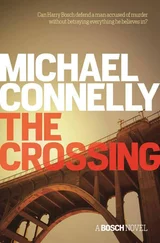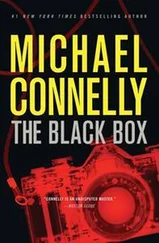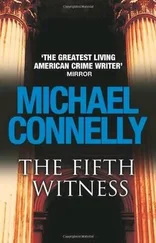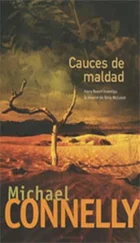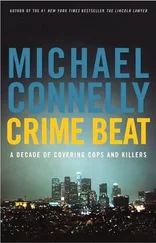“You want to make sugar?” Bosch asked.
“No, man, it’s just what the property was used for at one time. Now you’d probably buy it, fix it up, and make it a bed-and-breakfast or something.”
Bosch just nodded. Pratt was moving into a world he knew and cared nothing about.
“Anyway,” Pratt said, sensing he didn’t have an audience, “I’ll see you. And by the way, it’s nice that you got dressed up for the OIS. Most guys on home duty would’ve slogged in here in jeans and a T-shirt, looking more like a suspect than a cop.”
“Yeah, no problem.”
Pratt left the office and Bosch waited thirty seconds for him to get the elevator. He then put a stack of files on one of the evidence cartons and carried it all out the door. He was able to take it down and out to his car and get back before Pratt returned from the cafeteria. He then took the second carton and left. No one questioned what he was doing or where he was going with the materials.
After pulling out of the pay lot Bosch checked his watch and saw that he had less than an hour to kill before he was supposed to meet Rachel for lunch. It wasn’t enough time to drive home, drop the documents and come back-besides, that would be a waste of time and gas. He thought about canceling the lunch so he could go home right away and get going on the review of the records, but he decided against it because he knew Rachel would be a good sounding board and might even have some ideas about what Waits had meant when he yelled during the shooting.
He could also get to the restaurant early and start his review while waiting at the table for Rachel. But he knew that might cause a problem if a customer or waiter happened to catch a glimpse of some of the photos in the murder books.
The city’s main library was located in the same block as the restaurant, and he decided he would go there. He could do some file work in one of the private cubicles and then meet Rachel on time at the restaurant.
After parking in the garage beneath the library he carried the murder books from the Gesto and Fitzpatrick cases with him onto the elevator. Once inside the confines of the sprawling library, he found an open cubicle in a reference room and set to work reviewing the documents he had brought. Since he had begun rereading the Gesto files in Rider’s hospital room, he decided to stick with them and finish his review.
Moving through the book in the order the documents and reports were filed, he didn’t reach the Investigative Chronology-usually filed at the back of a murder book-until the end. He casually read through the 51 forms, and nothing about the investigative moves made, the subjects interviewed or the calls received hit him as any more important than when they had been originally added to the chrono.
Then suddenly he was struck by what he had not seen in the chronology. He quickly flipped pages backwards until he came to the 51 for September 29, 1993, and looked for the entry on the call Jerry Edgar had taken from Robert Saxon.
It wasn’t there.
Bosch leaned forward to read the document more clearly. This made no sense. In the official murder book the entry was there. Raynard Waits’s alias, Robert Saxon. The entry date was September 29, 1993, and the time of the call was 6:40 p.m. Olivas had found it during his review of the case and the next day in O’Shea’s office Bosch had seen it clear as day. He had studied it, knowing that it was confirmation of an error that allowed Waits another thirteen years of freedom to kill.
But the entry was not in Bosch’s copy of the murder book.
What the hell?
At first Bosch couldn’t put it together. The copy of the chronology in front of him was made four years earlier, when Bosch had decided to retire. He had secretly copied murder books from a handful of open cases that still gnawed at his insides. They were his retirement cases. His plan had been to work them on his own and at his leisure, to solve them before he could finally let the mission go and sit on a beach in Mexico with a fishing pole in one hand and a Corona in the other.
But it didn’t work out that way. Bosch learned that the mission was best served with a badge and he came back to the job. After he was assigned with Rider to the Open-Unsolved Unit, one of the first murder books he pulled out of Archives was the Gesto case. The book he pulled was the live record, the investigative file that was updated each time he or anybody else worked it. What he had in front of him was a copy that had sat on a shelf in his closet and had not been updated in four years. Even so, how could one have a notation entered on a 51 form in 1993, while the other one didn’t?
The logic of it dictated only one answer.
The official record of the investigation had been tampered with. The notation entering the name Robert Saxon into the murder book was added after Bosch had made his copy of the book. That of course left a four-year window during which the false notation could have been added, but common sense told Bosch he was dealing with days, not years.
Just a few days earlier Freddy Olivas had called him, looking for the murder book. Olivas took possession of the book and then became the one who discovered the Robert Saxon entry. It was Olivas who had brought it to light.
Bosch flipped through the chronology. Almost all of the pages corresponding with the dates of the initial investigation were filled in completely with time-marked notations. Only the page marked September 29 had space at the bottom. This would have allowed Olivas to remove the page from the binder, type in the Saxon entry and then return it to its place, setting the stage for his supposed discovery of this link between Waits and Gesto. Back in 1993 Bosch and Edgar did the 51s on a typewriter in the Hollywood squad room. It was all done on computer now but there were still plenty of typewriters around most squad rooms for the old-school cops-like Bosch-who couldn’t quite grasp the idea of working on a computer.
Bosch felt a heavy mixture of relief and anger start to overtake him. The burden of guilt over the mistake he and Edgar had supposedly made was lifting. They were in the clear and he needed to tell Edgar as soon as he could. But Bosch couldn’t embrace the feeling-not yet-because of the growing rage he felt at being victimized by Olivas. He stood up and walked away from the cubicle. He stepped out of the reference room and into the library’s main rotunda, where a circular mosaic high up on the walls told the story of the city’s founding.
Bosch felt like yelling something, exorcising the demon, but he kept quiet. A security guard walked quickly across the floor of the cavernous structure, maybe on his way to put the collar on a book thief or a flasher in the stacks. Bosch watched him go and then went back to his own work.
Back in the cubicle he tried to think through what had happened. Olivas had tampered with the murder book, typing a two-line entry into the chronology that would make Bosch believe he had made a profound mistake in the early stages of the investigation. The entry said that Robert Saxon had called to report seeing Marie Gesto at the Mayfair Supermarket on the afternoon she had disappeared.
That was all. It wasn’t the content of the call that was important to Olivas. It was the caller. Olivas had wanted to somehow get Raynard Waits into the murder book. Why? To put Bosch on some sort of a guilt trip that would allow Olivas the upper hand and control of the current investigation?
Bosch dismissed this. Olivas already had the upper hand and control. He was lead investigator in the Waits case and Bosch’s proprietary hold on the Gesto case would not change that. Bosch was along for the ride, yes, but he wasn’t steering the car. Olivas was steering, and therefore the Robert Saxon name plant was not necessary.
Читать дальше



